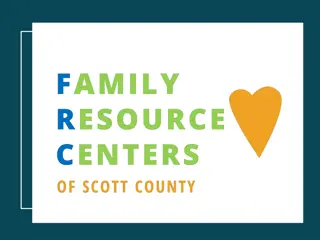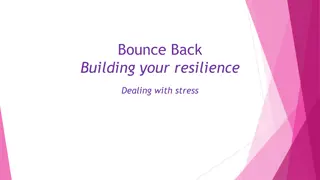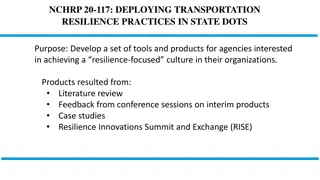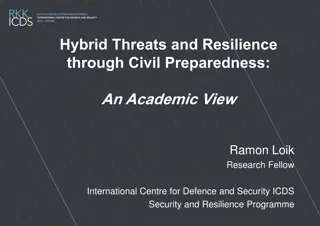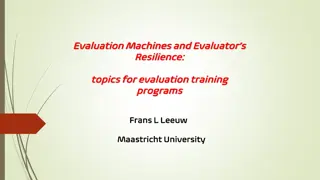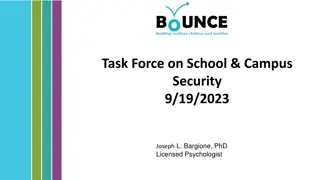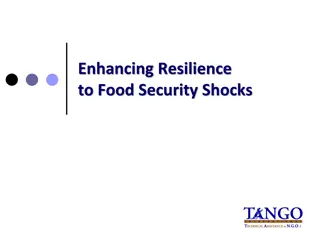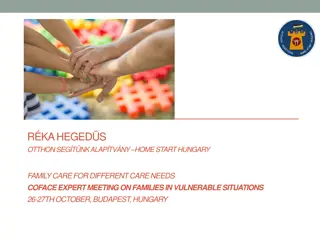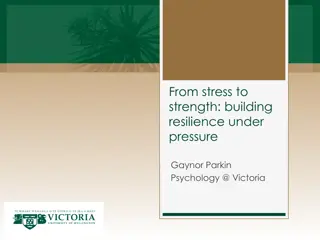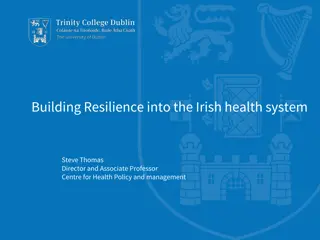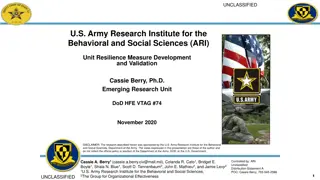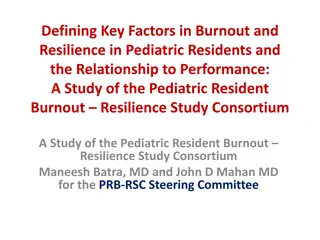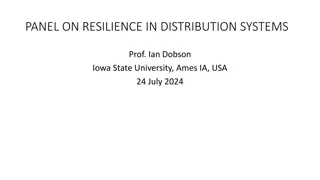Building Resilience: A Guide for Families
Explore examples of adversity and the importance of resilience. Learn what resilience is, how it can be developed, and why it matters. Discover ways parents and caregivers can assist children in building resilience through practical strategies. Myth versus reality around resilience is debunked, emphasizing the significance of positive experiences in resilience-building. Actionable steps for families to nurture resilience in children and themselves are outlined, focusing on making connections, instilling coping skills, and fostering a positive outlook.
Download Presentation

Please find below an Image/Link to download the presentation.
The content on the website is provided AS IS for your information and personal use only. It may not be sold, licensed, or shared on other websites without obtaining consent from the author. Download presentation by click this link. If you encounter any issues during the download, it is possible that the publisher has removed the file from their server.
E N D
Presentation Transcript
Building Resilience PTA.org /HealthyLifestyles
Session Objectives 1. Explore examples of adversity. 2. Discuss what resilience is and is not, and why it is important. 3. Practice ways you as parents and caregivers can help the children in your lives build resilience. P TA . o rg / H e a l t hy L i fe s t y l e s
What is Adversity? Types of Adversity: Physical Adversity Mental Adversity Emotional Adversity Social Adversity Financial Adversity Adversity noun ad ver si ty | \ ad- v r-s -t \ grave or persistent difficulty, misfortune or tragedy. P TA . o rg / H e a l t hy L i fe s t y l e s
What is Resilience? Resilience noun re sil ience | \ r zily ns \ the capacity to recover quickly from difficulties; toughness. Healthy Thinking Meaning Connection Wellness P TA . o rg / H e a l t hy L i fe s t y l e s
What does someone who is resilient look like?
Why is Resilience Important? Being Resilient: 1. Helps you get through difficult circumstances. 2. Empowers you to grow. 3. Improves your life along the way. Source: Harvard University Center on the Developing Child P TA . o rg / H e a l t hy L i fe s t y l e s
Myth Versus Reality What Many Think: Resilience can only come from a negative experiences. Resilient people never feel down or hopeless. People can have experienced too many negative things to build resilience. What is Real: Resilience can be developed from both positive and negative experiences. Someone who is resilient can still struggle with mental and emotional challenges. It is never too late to build resilience. P TA . o rg / H e a l t hy L i fe s t y l e s
What Can Families Do? Making connections Having your child help others Maintaining a daily routine Practicing healthy coping skills Teaching child self-care P TA . o rg / H e a l t hy L i fe s t y l e s
What Can Families Do? Moving towards their goals Nurturing a positive self-view Maintaining a hopeful outlook Looking for opportunities for self discovery Accepting change PTA.org /HealthyLifestyles
Participant Activity 1: Practicing Gratitude Healthy Coping Strategies Having fun or playing Laughing Drawing, painting or coloring Journaling Deep breathing Meditation Connecting with others Talking it out Exercising Cooking Listening to music Practicing gratitude P TA . o rg / H e a l t hy L i fe s t y l e s
Participant Activity 2: What Helps You Cope? Take turns asking each other these questions. 1. What coping strategies have you used to get yourself get through the COVID-19 pandemic? 2. How have you helped your child get through it? P TA . o rg / H e a l t hy L i fe s t y l e s
Participant Activity 3: What Would You Do? Work together to figure out: Your child comes home from school and tells you someone they thought was their friend started spreading an embarrassing story about them around school, and now everyone is making fun of them. 1. How would you help your child overcome this situation? 2. How can you help your child avoid a similar situation in the future? P TA . o rg / H e a l t hy L i fe s t y l e s
Participant Activity 4: Create a Building Resilience Family Action Plan How will you commit to helping the child in your life build resilience? P TA . o rg / H e a l t hy L i fe s t y l e s
Getting Help Mental heath support is available through Your doctor Your school Your community Your PTA Resources at PTA.org/HealthyMinds PTA.org /HealthyLifestyles






